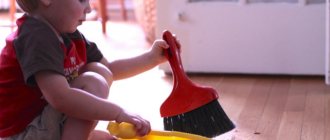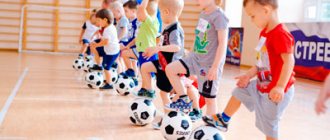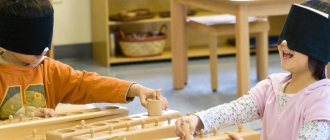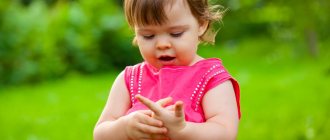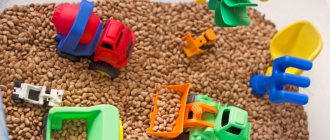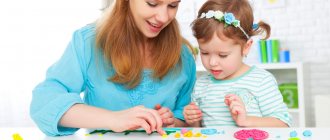Objectives, content and methods of sensory education for children of early preschool age
Kolbukhova Tatyana Vladimirovna
Objectives, content and methods of sensory education for children of early preschool age
Objectives , content and methods of sensory education for children of early preschool age
Sensory development (from Latin sensus - feeling, sensation)
involves the child’s formation of processes
of perception and ideas about objects, objects and phenomena of the surrounding world. A person is born with sensory organs ready to function. But these are only prerequisites for perceiving the surrounding reality. Full sensory development is carried out only in the process of sensory education , when children purposefully form standard ideas about color, shape, size, the signs and properties of various objects and materials , their position in space, etc., all types of perception , thereby laying the foundation for the development of mental activity.
Sensory education creates the necessary prerequisites for the formation of mental functions that are of paramount importance for the possibility of further learning. It is aimed at developing visual, auditory, tactile, kinetic, kinesthetic and other types of sensations and perceptions .
The importance of sensory development for his future life confronts the theory and practice of preschool education with the task of developing and using the most effective means and methods of sensory education in kindergarten . The main direction of sensory education should be to equip the child with sensory culture .
The concept of " sensory culture "
entered
preschool pedagogy thanks to the works of M. Montessori. However, she believed that in order to acquire such a culture, it is enough to systematically exercise the child’s senses in distinguishing the shape, color, size and other properties of objects . This point of view was erroneous; it did not take into account that the development of a child is fundamentally different from the development of young animals . A child develops through “social inheritance,”
which, unlike biological inheritance, does not involve the exercise of innate abilities, but the acquisition of new ones through the assimilation of social experience.
sensory culture is the result of his assimilation of sensory culture created by humanity (generally accepted ideas about color, shape and other properties of things)
.
At each age stage, a child turns out to be the most sensitive to certain influences. In this regard, each age level becomes favorable for the further neuropsychic development and comprehensive education of a preschooler . The younger the child, the more important sensory experience is in his life. At the stage of early childhood, familiarization with the properties of objects plays a decisive role. As we have already indicated above, early age is the “golden time”
of sensory education , according to Professor N. M. Shchelovanov.
Sensory education of a child in the first three years of life is aimed at ensuring the normal development of the functions of the analyzers and the formation of the perception of objects - sensory knowledge of individual properties (shape, size, position in space, sounds, etc.)
as signs
of objects that determine the possibility and nature of performing elementary actions with these objects - grasping and manipulation.
The main condition for the proper upbringing of a young child is to ensure a sufficient variety of external influences, the organization of the visual and auditory world in which the baby exists (L. A. Wenger, Sh. A. Abdullaeva, E. G. Pilyugiga, N. P. Sakulina, etc. .).To fulfill this condition, it is necessary: appropriate equipment of the room and especially the space surrounding the child, constant communication between the adult and the child, systematic conduct of special classes.
Sensory education in the second and third years of life consists, first of all, in teaching children objective actions that require the correlation of objects by their external characteristics: size, shape, position in space. Mastering knowledge about the external properties of objects is achieved by correlating them with each other (since at this stage children do not yet have standard ideas)
.
Research by methodologists has revealed the most optimal way to master the correct execution of actions - from practical tests to performing actions using visual correlation. Specially organized classes with didactic material, didactic toys, tools and building materials are the main form of work on sensory education of children of the second and third year of life (S. L. Novoselova, L. N. Pavlova, E. G. Pilyugina, etc. )
.
In addition, the development of perception permeates all aspects of children's activity: the development of movements, play activities, speech communication, musical education , visual activity and serves as the most important prerequisite for their further development.
At each age, sensory education has its own tasks , and a certain element of sensory culture .
In the first year of life, the main task is to provide the child with sufficient wealth and variety of external impressions and to develop attention to the properties of objects . When the baby begins to develop grasping movements, another task is added task Gradually, such an adaptation will lead to the fact that these properties will begin to acquire a certain meaning for the baby ( “small”
- this is something that can be grabbed with one hand,
“large”
- with two hands,
“round”
- something that is covered with the entire
palm , “square”
- something that is taken with fingers grasping the object on both sides, etc.) .
The term “
sensory standards ” was proposed by A.V. Zaporozhets and has found wide application in work on
sensory education of preschool children .
A sensory standard is a certain quality of an object that was identified in the process of human development (for example, an apple is round, smooth)
.
All sensory qualities have their own verbal names: color, taste, shape, weight, etc.
Development stages:
1. Children under 2 years old reflect only individual features of objects . For example, taste, then sound.
2. Children 3-5 years old can assign certain qualities to a specific subject , the so-called subject standards. For example, an apple is sweet, and they will be very surprised if they try an apple and it turns out to be sour.
3. Children aged 5-7 years master generally accepted standards. For example, an apple is round, sweet, and maybe sour.
Sensory education during this period is the main type of education in general . Providing an influx of ever new impressions, it becomes necessary not only for the development of the activity of the senses, but also for the normal general physical and mental development of the child. It is known that when the influx of impressions is limited, infants experience “ sensory hunger ”
, leading to significant delays in overall development.
We can highlight the main tasks in the sensory education of children from birth to 6 years.
In the first year of life, this is the enrichment of the child with impressions. Conditions should be created for the baby so that he can follow moving bright toys and grab objects of different shapes and sizes.
In the second or third year of life, children must learn to identify color, shape and size as special characteristics of objects , accumulate ideas about the main varieties of color and shape and the relationship between two objects in size.
Starting from the fourth year of life, children form sensory standards : stable ideas about colors, geometric shapes, and relationships in size between several objects, enshrined in speech. Later, they should be introduced to shades of color, to variations of geometric shapes, and to the relationships in size that arise between the elements of a series consisting of a larger number of objects .
Simultaneously with the formation of standards, it is necessary to teach children how to examine objects : grouping them by color and shape around standard samples, sequential inspection and description of the shape, and performing increasingly complex visual actions.
Finally, a special task analytical perception in : the ability to understand combinations of colors, dismember the shape of objects , and isolate individual dimensions of size.
Particularly important is the question of the connection between sensory education , carried out using the proposed system, and sensory education , carried out when teaching productive activities (drawing, modeling, etc.)
.
Productive activities begin to take shape in the third year of a child’s life, but learning at this age does not yet occupy a significant place. Therefore, for young children it does not yet make sense to distinguish between productive activities and didactic games and exercises for sensory education .
Based on this, the main task of sensory education for preschool children has been determined - the formation in children of such skills to perceive and imagine objects and phenomena that would contribute to the improvement of the processes of drawing, design, sound analysis of words, work in nature, etc.
Modern program and methodological manuals pay considerable attention to the problem of sensory education . Specially organized sensory education for young children . Initially, this work involves the accumulation of sensory representations and involves the creation of the child’s environment (speech and non-speech sounds, varied and sufficient visual impressions) and special classes in sensory education (in the first year of life)
.
Subsequently, classes are conducted in which didactic games and exercises are used with specially designed aids (liners and grids, colored sticks, teaching tables, bushings, etc.). Further sensory development is carried out in the process of learning to draw, basic design, and in the process of everyday life.
Currently, in the field of psychology of children's perception, there is an opinion that among the many tasks of sensory education, the most important are :
— creating conditions conducive to the development of children’s broad orientation in the objective world around them;
— the formation of generalized methods of examining objects , their properties and relationships; mastering the necessary sensory base ;
- timely and correct connection of experience with words;
— formation of a plan of presentations (Gavrilushkina O.P., Kataeva A.A., Sokolova N.D., Strebeleva E.A., etc.)
Sensory education is carried out during the formation of the main types of children's activities, which are characteristic of children with both normal and abnormal development - object, play, visual (O. P. Gavrilushkina, A. A. Kataeva, E. A. Strebeleva, etc. )
.
, young children are taught to identify the properties and relationships of objects based on their assimilation of perceptual actions and sensory standards . Thus, in the course of teaching constructive activities to young children, O. P. Gavrilushkina puts forward the task of mastering the methods and actions of perception .
The program for the education and training of young children provides special exercises aimed at developing the ability to distinguish, compare, highlight, and group objects and elements of building sets by shape, size, and location. It is recommended to pay special attention to learning to examine an object, analyze it, and foresee the future result of action with it. These skills are a necessary condition for the formation of the indicative phase of activity and largely determine the success of completing the task .
In the process of forming the visual activity of young children in the preparatory period of education, it is proposed to use special didactic games aimed at training children in the perception of various properties of objects , as well as games to develop hand-eye coordination. In the process of conducting classes on object drawing and sculpting from life, children are taught special examination, observation, during which the properties of an object are perceived . A special place in the work is occupied by examination training, which includes: a holistic perception of the subject ; highlighting the main parts; analysis of shape, color, location and relative size of parts; repeated holistic perception of an object . The correct perception of the shape of an object is ensured by individual work on the formation of modeling movements (outlining objects along the contour before drawing, feeling before sculpting) in the classes of a speech pathologist teacher (O. P. Gavrilushkina)
.
An important condition for the development of the sensory sphere is the need to use all methods of transmitting sensory experience , selecting program tasks in accordance with the requirements of sensory development , regardless of the level of speech development of the child; everyday design and consolidation of the child’s own speech experience in words, the creation of images of representations that can be updated by word. The system of sensory education should include special work on mastering all methods of assimilation of sensory experience - understanding gesture instructions, imitation, analysis of a sample, independent analysis of a task , action according to verbal instructions or a verbal description.
Generalization of practical experience in this area led to the creation of a number of sensory development .
Of interest is the system of didactic and educational games proposed by M. B. Medvedeva and T. P. Babich. This system aims to develop “targeted perception of color , shape and size, object representations, orientation in space, visual attention, analytical and synthetic activity.” and represents a fairly clear and reasonable sequence of work. the authors propose to formulate ideas about the size of objects of objects by size , by total volume (matryoshka dolls, pyramids)
;
verbal designation of objects by size : show a long, short path; arranging objects in ascending or descending order ;
localization of quantity; development of the eye; sense of rhythm; games and exercises to develop visual attention. According to researchers, one of the most important approaches to determining a social and labor forecast is the ability to spatial, temporal and sensory orientation (N. F. Dementieva, N. M. Dotsenko, E. V. Ustinova)
.
As a result, all existing programs and methodological recommendations related to working with children include tasks for the development of the sensory-perceptual sphere . It is recommended to carry out work on sensory education in the process of developing object-practical (G.V. Tsikoto, visual (A.A. Eremina), gaming (A.R. Maller)
and elementary labor activities. The main form of work in this direction is exercise and didactic a game.
At the end of the theoretical analysis, the following conclusions can be drawn:
1. An analysis of psychological and pedagogical literature on the problem of sensory-perceptual development and sensory education of young children shows that currently perception is considered as a special activity that has a motivational-personal and operational-technical component in its structure.
2. Children of early and preschool age have organic prerequisites for sensory development in the form of natural anatomical and physiological characteristics of the analyzer systems. However, it has been established that these prerequisites are not enough for a child to independently initially master human experience.
3. The development of perception is carried out in the process of sensory education , understood in a broad pedagogical sense - as a purposeful process that is carried out under the guidance of a teacher and includes all types of training sessions and specially conducted educational work .
4. The most important tasks of sensory education are :
— creating conditions conducive to the development of children’s broad orientation in the objective world around them;
- the formation of generalized methods of examining objects , their properties and relationships, the assimilation of the necessary sensory base ;
- timely and correct connection of experience with words;
— formation of a plan of presentations (Gavrilushkina O.P., Kataeva A.A., Sokolova N.D., Strebeleva E.A., etc.)
— formation of systems of perceptual actions in children ;
- formation in children of systems of sensory standards - generalized ideas about the properties, qualities and relationships of objects ;
— formation of skills to independently apply systems of perceptual actions and systems of standards in practical and cognitive activities.
What is sensory development?
Sensory development is the process of forming a child’s perceptions and ideas about the world around him and the properties of objects. Babies do not have developed abstract thinking; they experience life through sensations that underlie the mental and physical development of children.
First, babies learn to distinguish their mother’s voice from strangers, as well as recognize individual sounds, distinguish objects by weight and color; young children do not have access to spatial thinking, they think objectively.
Regular activities with your child will help the correct development of his sensory perception and personality formation.
